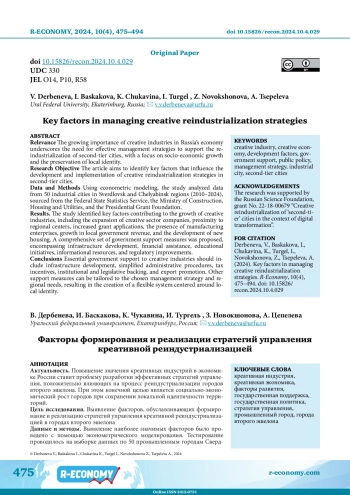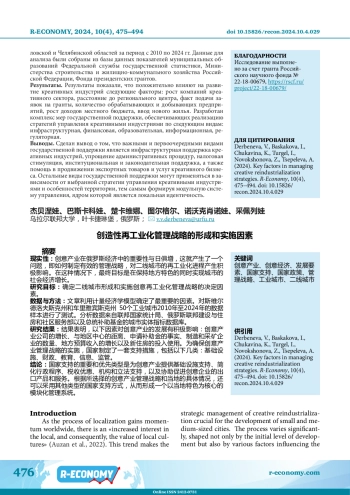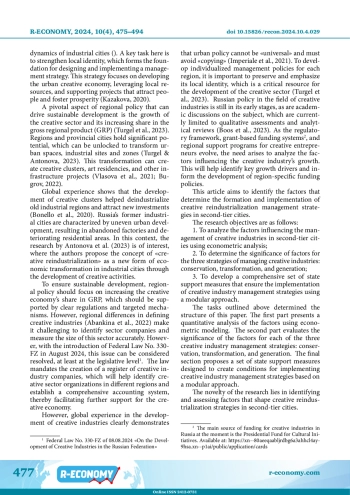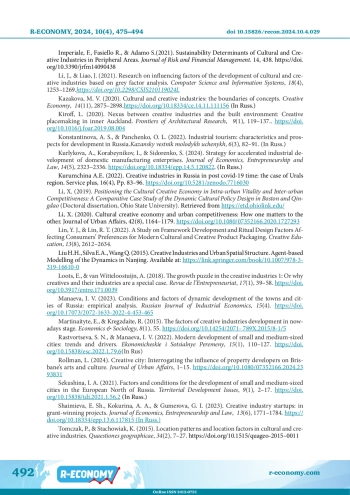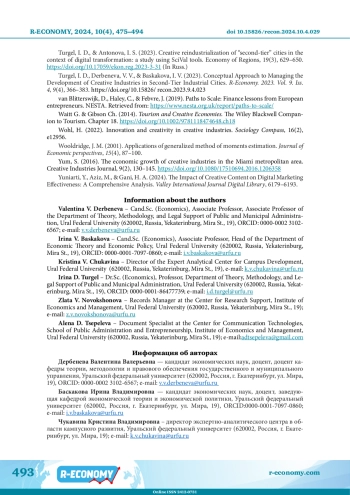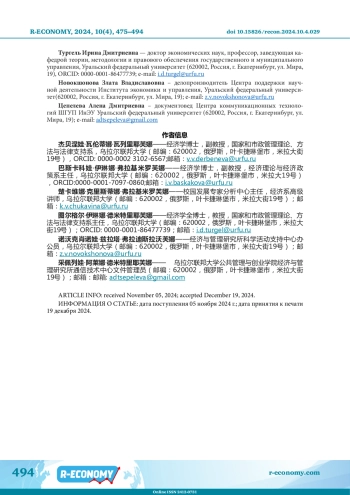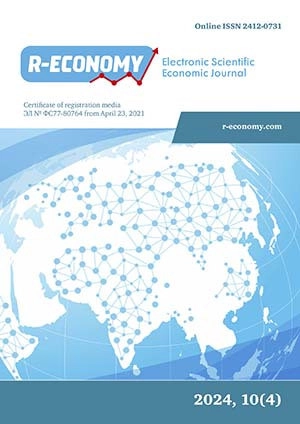Relevance The growing importance of creative industries in Russia’s economy underscores the need for effective management strategies to support the reindustrialization of second-tier cities, with a focus on socio-economic growth and the preservation of local identity. Research Objective The article aims to identify key factors that influence the development and implementation of creative reindustrialization strategies in second-tier cities. Data and Methods Using econometric modeling, the study analyzed data from 50 industrial cities in Sverdlovsk and Chelyabinsk regions (2010-2024), sourced from the Federal State Statistics Service, the Ministry of Construction, Housing and Utilities, and the Presidential Grant Foundation. Results. The study identified key factors contributing to the growth of creative industries, including the expansion of creative sector companies, proximity to regional centers, increased grant applications, the presence of manufacturing enterprises, growth in local government revenue, and the development of new housing. A comprehensive set of government support measures was proposed, encompassing infrastructure development, financial assistance, educational initiatives, informational resources, and regulatory improvements. Conclusions Essential government support to creative industries should include infrastructure development, simplified administrative procedures, tax incentives, institutional and legislative backing, and export promotion. Other support measures can be tailored to the chosen management strategy and regional needs, resulting in the creation of a flexible system centered around local identity.
Идентификаторы и классификаторы
As the process of localization gains momentum worldwide, there is an «increased interest in the local, and consequently, the value of local cultures» (Auzan et al., 2022). This trend makes the strategic management of creative reindustrialization crucial for the development of small and medium-sized cities. The process varies significantly, shaped not only by the initial level of development but also by various factors influencing the dynamics of industrial cities (). A key task here is to strengthen local identity, which forms the foundation for designing and implementing a management strategy. This strategy focuses on developing the urban creative economy, leveraging local resources, and supporting projects that attract people and foster prosperity (Kazakova, 2020).
Список литературы
1. Abankina T. A., Boss V. O., Bredikhin S. V. (2022). Creative industries. Moscow, 221 p. (In Russ.).
2. Antonova I. S., Pchelintsev E. A., Maleeva E. A. (2023) Second-tier cities of creative reindustrialization: Search for insights. Vestnik Tomskogo gosudarstvennogo universiteta. Ekonomika - Tomsk State University Journal of Economics. 61. pp. 74-95. (In Russian). DOI: 10.17223/19988648/61/6 EDN: ULXLNX
3. Auzan A., Bakhtigaraeva A., Bryzgalin V. (2022). Development of Russia’s creative economy in the context of modern challenges. Journal of the New Economic Association, 54(2), 213-220.
4. Babina E. N., Barashkina E. V., Beganskaya I. Yu. et al. (2024). Creative industries as an imperative for economic growth: cross-innovation and sustainable development: a monograph. Beganskaya I.Yu., Podkopaeva O.A. (Eds). Samara: LLC Research and Publishing Center “PNK”, 214 p. (In Russ.).
5. Baskakova I. V., Derbeneva V. V., Turgel I. D., Tsepeleva A. (2023). Local identity as the basis for the formation of creative clusters in the cities of the Urals and Siberia. Creative Economy, 17(12), 4729-4748. (In Russ.). DOI: 10.18334/ce.17.12.119949 EDN: GLSCLP
6. Bonello V., Faraone C., Gambarotto F., Nicoletto L., Pedrini G. (2020). Clusters in formation in a deindustrialized area: urban regeneration and structural change in Porto Marghera (Venice). Competitiveness Review: An International Business Journal, 30(4), 417-436. DOI: 10.1108/CR-12-2019-0129 EDN: GQFOXO
7. Borowiecki K. J., Navarrete T. (2016). The Economic and Fiscal Dimension of Cultural Heritage, European Policy Brief. Retrieved from http://hdl.handle.net/1765/115237.
8. Boos V. O., Shubina V. I., Kutsenko E. S. (2023). Boos V.O., Shubina V.I., Kutsenko E.U. Regions of Russia in the focus of the creative policy quality index. Regional Research, 4 (82), 53-65. (In Russ.). DOI: 10.5922/1994-5280-2023-4-5
9. Breul M., Nguyen T. X. (2022). The impact of extractive industries on regional diversification - evidence from Vietnam. The Extractive Industries and Society. 11, 100982. DOI: 10.1016/j.exis.2021.100982 EDN: JTLMQS
10. Bugrov K. D. (2022). Kreativnye strategii trubnykh predpriyatii Urala: mezhdu reindustrializatsiei i memorializatsiei [Creative Strategies of Ural Pipe Companies: Between Technological Heroism and Memorialization]. Tempus et Memoria, 3, 2, 13-22. DOI: 10.15826/tetm.2022.2.033 EDN: NXISQM
11. Cicchiello A. F., Gallo S., Monferrà S. (2023). Financing the cultural and creative industries through crowdfunding: the role of national cultural dimensions and policies. Journal of Cultural Economics. 47,133-175. DOI: 10.1007/s10824-022-09452-9 EDN: QLEJPK
12. Evmenov A., Enikeeva L., Sorvina T. (2023). Development of infrastructure supporting the growth and sustainable economic development of creative industries in Saint Petersburg within the framework of creating a unified cultural space in the Northwest region Creative Economy 17(8), 2859-2872. (In Russ.). DOI: 10.18334/ce.17.8.118663 EDN: ACILJX
13. Fazlagić J., Szczepankiewicz E. I. (2020).The Role of Local Governments in Supporting Creative Industries-A Conceptual Model. Sustainability, 12(1), 438;. DOI: 10.3390/su12010438 EDN: VACNRH
14. Vlasov V. V., Gershman M. A., Gokhberg L. M., Kutsenko E. S., Popova Ya. A., Bredikhin S. V.,..., Maksimenko D. D. (2021). Creative economy of Moscow in numbers. 108 p. (In Russ.).
15. Gulyaeva N. S. (2019). Promoting youth employment at the local level in the context of developing creative industries. A study of contemporary societal issues in the context of social work and social security tasks. Proceedings of the All-Russian 14th Open Youth Scientific and Practical Conference. Volume Issue 7. Moscow, 2019, pp. 202-205 (In Russ.).
16. Sugiardi S. (2024). Economic diversification strategies to improve the welfare of rural communities: literature analysis and practical implications. International journal of financial economics, 1(5), 1014-1022.
17. Fleischmann K., Welters R., Daniel R. (2017). Creative industries and regional economic development: can a creative industries hub spark new ways to grow a regional economy? Australasian Journal of Regional Studies. 23(2), 217-242.
18. Handke,C., Dalla Chiesa C. (2022). The art of crowdfunding arts and innovation: The cultural economic perspective. Journal of Cultural Economics, 46(2), 249-284. DOI: 10.1007/s10824-02 EDN: QOYGCQ
19. Imperiale F., Fasiello R., Adamo S.(2021). Sustainability Determinants of Cultural and Creative Industries in Peripheral Areas. Journal of Risk and Financial Management. 14, 438. DOI: 10.3390/jrfm14090438 EDN: MNWYZW
20. Li J., Liao J. (2021). Research on influencing factors of the development of cultural and creative industries based on grey factor analysis. Computer Science and Information Systems, 18(4), 1253-1269. DOI: 10.2298/CSIS210119024L EDN: BNUUIV
21. Kazakova M. V. (2020). Cultural and creative industries: the boundaries of concepts. Creative Economy, 14(11), 2875-2898. (In Russ.). DOI: 10.18334/ce.14.11.111156 EDN: UBQMSQ
22. Kiroff L. (2020). Nexus between creative industries and the built environment: Creative placemaking in inner Auckland. Frontiers of Architectural Research, 9(1), 119-137.. DOI: 10.1016/j.foar.2019.08.004 EDN: URQHFV
23. Konstantinova A. S., Panchenko O. L. (2022). Industrial tourism: characteristics and prospects for development in Russia.Kazansky vestnik molodykh uchenykh, 6(3), 82-91. (In Russ.).
24. Kurlykova A., Korabeynikov I., Sidorenko S. (2024). Strategy for accelerated industrial development of domestic manufacturing enterprises. Journal of Economics, Entrepreneurship and Law, 14(5), 2323-2336. (In Russ.). DOI: 10.18334/epp.14.5.120822 EDN: CDPTVF
25. Kurumchina A. E. (2022). Creative industries in Russia in post covid-19 time: the case of Urals region. Service plus, 16(4), Рр. 83-96. DOI: 10.5281/zenodo.7716030
26. Li X. (2019). Positioning the Cultural Creative Economy in Intra-urban Vitality and Inter-urban Competitiveness: A Comparative Case Study of the Dynamic Cultural Policy Design in Boston and Qingdao (Doctoral dissertation, Ohio State University). Retrieved from https://etd.ohiolink.edu. EDN: QIIUSY
27. Li X. (2020). Cultural creative economy and urban competitiveness: How one matters to the other. Journal of Urban Affairs, 42(8), 1164-1179. DOI: 10.1080/07352166.2020.1727293 EDN: NRSNQC
28. Lin Y. J., Lin,R. T. (2022). A Study on Framework Development and Ritual Design Factors Affecting Consumers’ Preferences for Modern Cultural and Creative Product Packaging. Creative Education, 13(8), 2612-2634. EDN: SLHVTL
29. Liu H. H., Silva E. A., Wang Q. (2015). Creative Industries and Urban Spatial Structure. Agent-based Modelling of the Dynamics in Nanjing. Available at: https://link.springer.com/book/. DOI: 10.1007/978-3-319-16610-0
30. Loots E., van Witteloostuijn,A. (2018). The growth puzzle in the creative industries 1: Or why creatives and their industries are a special case. Revue de l’Entrepreneuriat, 17(1), 39-58. DOI: 10.3917/entre.171.0039
31. Manaeva I. V. (2023). Conditions and factors of dynamic development of the towns and cities of Russia: empirical analysis. Russian Journal of Industrial Economics, 15(4). DOI: 10.17073/2072-1633-2022-4-453-465 EDN: YPUOQR
32. Martinaityte E., Kregzdaite R. (2015). The factors of creative industries development in nowadays stage. Economics & Sociology, 8(1), 55. DOI: 10.14254/2071-789X.2015/8-1/5
33. Rastvortseva S. N., Manaeva I. V. (2022). Modern development of small and medium-sized cities: trends and drivers. Ekonomicheskie i Sotsialnye Peremeny, 15(1), 110-127. (In Rus). DOI: 10.15838/esc.2022.1.79.6 EDN: BSCIBL
34. Rollman L. (2024). Creative city: Interrogating the influence of property developers on Brisbane’s arts and culture. Journal of Urban Affairs, 1-15. DOI: 10.1080/07352166.2024.2393831
35. Sekushina I. A. (2021). Factors and conditions for the development of small and medium-sized cities in the European North of Russia. Territorial Development Issues, 9(1), 2-17. (In Russ.). DOI: 10.15838/tdi.2021.1.56.2 EDN: PABNFP
36. Shaimieva E. Sh., Kokurina A. A., Gumerova G. I. (2023). Creative industry startups: in grant-winning projects. Journal of Economics, Entrepreneurship and Law, 13(6), 1771-1784. (In Russ.). DOI: 10.18334/epp.13.6.117815 EDN: JZJAZN
37. Tomczak P., Stachowiak K. (2015). Location patterns and location factors in cultural and creative industries. Quaestiones geographicae, 34(2), 7-27. DOI: 10.1515/quageo-2015-0011
38. Turgel I. D., Antonova I. S. (2023). Creative reindustrialization of “second-tier” cities in the context of digital transformation: a study using SciVal tools. Economy of Regions, 19(3), 629-650. (In Russ.). DOI: 10.17059/ekon.reg.2023-3-31 EDN: DRPKFM
39. Turgel I. D., Derbeneva V. V., Baskakova I. V. (2023). Conceptual Approach to Managing the Development of Creative Industries in Second-Tier Industrial Cities. R-Economy. 2023. Vol. 9. Iss. 4, 9(4), 366-383. DOI: 10.15826/recon.2023.9.4.023 EDN: BRAACH
40. van Blitterswijk D., Haley C., Febvre J. (2019). Paths to Scale: Finance lessons from European entrepreneurs. NESTA. Retrieved from: https://www.nesta.org.uk/report/paths-to-scale.
41. Waitt G., Gibson Ch. (2014). Tourism and Creative Economies. The Wiley Blackwell Companion to Tourism. Chapter 18. DOI: 10.1002/9781118474648.ch18
42. Wohl H. (2022). Innovation and creativity in creative industries. Sociology Compass, 16(2), e12956. EDN: JOJBVR
43. Wooldridge J. M. (2001). Applications of generalized method of moments estimation. Journal of Economic perspectives, 15(4), 87-100. EDN: DQPHCB
44. Yum S. (2016). The economic growth of creative industries in the Miami metropolitan area. Creative Industries Journal, 9(2), 130-145. DOI: 10.1080/17510694.2016.1206358
45. Yuniarti Y., Aziz M., Gani H. A. (2024). The Impact of Creative Content on Digital Marketing Effectiveness: A Comprehensive Analysis. Valley International Journal Digital Library, 6179-6193.
Выпуск
Другие статьи выпуска
Relevance. Corruption remains a persistent issue in many countries, including Kazakhstan. By exploring the relationship between the socio-economic characteristics of specific regions and corruption, this research can provide a foundation for informed policy-making and targeted anti-corruption efforts and thus help mitigate its negative impact on regional development. Research Objective. The research aims to assess the impact of corruption on regional socio-economic development in Kazakhstan through the creation and application of a multifactor corruption index. Data and Methods. The study uses official statistical data on corruption offenses and regional socio-economic indicators, including industrial production, fixed asset investments, household expenditures, unemployment rates, and foreign trade volumes. A multifactor index methodology was employed, using Pearson correlation coefficients to calculate averaged absolute values of sub-indices for each indicator. Results. The study found strong correlations between corruption and socio-economic indicators in regions like East Kazakhstan, Abay, Akmola, and Kostanay. The economic structure of these regions plays a key role: East Kazakhstan and Akmola, with dominant mining industries, are more vulnerable to corruption due to public contracts and licensing. Kostanay’s agricultural sector, central to its economy, is prone to corruption in land allocation, subsidies, and procurement. The economic importance of these sectors amplifies the impact of corruption on development, strengthening the correlation. Conversely, regions with lower index values show weaker correlations in the analysis, likely due to economic diversity, incomplete data, or less effective governance mechanisms. Conclusions. The regional specificity of the interrelation between corruption and socio-economic development in Kazakhstan necessitates tailored approaches that consider the unique conditions of each region. These findings can be of interest to policymakers and other stakeholders. The proposed methodology allows for a more precise assessment of both hidden and visible corruption risks, highlighting critical areas for implementing effective anti-corruption measures.
Relevance. Technological sovereignty in the national economy cannot be achieved without a clear understanding of the state of regional industries, particularly their level of technological maturity. This crucial factor drives investment decisions and shapes regional development strategies. However, existing methods for assessing technological development often fail to account for industries’ reliance on foreign technologies and services. Research Objective. The study explores the concept of technological maturity in the context of managing regional industrial development, focusing on the case of regional industries in Russia. Data and Methods. To evaluate the technological maturity of regional industries, we propose an index derived from normalizing key indicators that capture the critical aspects of technological maturity. The normalized indicators are aggregated using the arithmetic mean. Correlation analysis was employed to identify factors influencing technological development. The study is based on official statistics from the Federal State Statistics Service (Rosstat) for 2022. Results. Technological maturity indices are calculated for Russian regions, identifying both strengths and weaknesses. Only nine regions have achieved a medium level of technological maturity, while most remain at low levels. Additionally, many regions leading in terms of technology are highly reliant on imported technologies and services, with minimal exports of domestically developed technologies. These results highlight the need for policy measures tailored to regions’ varying needs and levels of technological maturity. Conclusions The concept of technological maturity provides a strategic framework for regional industrial development that can enhance national economic competitiveness through both embracing modern technologies and ensuring technological independence. The technological maturity index provides a valuable tool for tracking key indicators of technological sovereignty in domestic industries and identifying investment priorities to strengthen it.
Relevance. Russia is currently facing sanctions, which have had significant economic and social consequences. These crises have revealed vulnerabilities in the socio-economic system, highlighting the importance of studying them to better address current challenges and mitigate future risks. Objective. The study aims to identify the vulnerabilities in particular aspects of sustainable development across Russia’s regions during the crises of the past 15 years. Data and methods. The study draws on data from the Federal Statistical Service (Rosstat) to calculate a sustainable development index for regions, which tracks the impact of crises on their economic, social, and environmental sustainability. The index is constructed using a classical method, comprising three averaged sub-indices, each representing one of the three components of sustainable development. A higher index value indicates greater sustainability, with the impact of crises varying across regions. Results. During the 2014 crisis, regions specializing in export-oriented industries or those with a significant share of foreign capital in their economies were hit the hardest. Socially, the most vulnerable regions were those along the Chinese border in the Far East, which were impacted by trade restrictions. The 2020 pandemic had economic effects on nearly all regions, with cities of over a million people and their agglomerations suffering the most due to the abrupt suspension of the tertiary sector. The social sphere responds most quickly to crises, while the environmental component is more inert but shows a negative trend despite the crises. Conclusions. For regions with underdeveloped and monocentric economies, support measures should focus on diversifying industries, particularly those aimed at mass consumption. In coal-mining regions, it’s important to develop service sectors related to the industry during stable periods. For the Far Eastern regions, the main support measure is to stimulate industries geared towards meeting Chinese demand.
Relevance. Inter-municipal cooperation is an effective tool for addressing resource deficits faced by municipalities, and its importance has grown in today’s context of socio-economic instability. However, the success of such cooperation largely depends on a careful selection of partners, which raises the question of how the strength of ties between municipalities impacts their ability to collaborate effectively. Research objective. The aim of this study is to explore how the spatial characteristics of interdependence between municipalities influence their interactions and cooperation. Data and methods. The research draws on official statistical data from Russia’s Federal State Statistics Service (Rosstat), as well as information from investment passports and municipal socio-economic development strategies. The study employs spatial correlation methods, cartographic analysis, and general research techniques, including analysis and synthesis. Results. The inter-municipal relationships in Sverdlovsk Region are highly uneven, with significant disparities in the level of involvement across different areas. These relationships are predominantly concentrated around the region’s administrative center and its neighboring municipalities, while the northern and eastern parts exhibit the weakest connectivity. Municipalities in the Ekaterinburg urban agglomeration are the most active participants in joint projects, whereas those in the southwestern part of the region show less involvement. The northern and eastern areas, in particular, demonstrate minimal engagement in forming partnerships with other municipalities, highlighting a stark regional imbalance. Conclusions. The study confirms a strong link between the interdependence of municipalities and the extent of their cooperation. Factors such as territorial and socio-economic proximity play a key role, but additional drivers, such as national or regional policies, also significantly influence inter-municipal collaboration. Interestingly, a lack of resources among potential partners does not appear to impede cooperation.
Relevance. The well-being of citizens is a key focus of national policies worldwide. Kazakhstan, however, is characterized by significant regional disparities in social well-being, which necessitates targeted programs and investments to improve conditions in less developed areas. Research Objective. This study aims to develop a national adaptive social well-being index to evaluate and spatially map the regions of Kazakhstan. Data and Methods. The methodology included identifying indicators through a literature review and regional data, conducting an expert survey to weight them, and creating a social well-being index. A spatial analysis was then used to calculate the index for each region. Results. The social well-being index shows significant disparities across regions. Astana, Almaty, and Atyrau demonstrate strong social welfare, driven by economic growth and advanced social infrastructure. In contrast, Karaganda, Pavlodar, and Shymkent show lower social welfare, highlighting the need for targeted interventions and investments. Conclusion. The findings offer valuable insights for policymakers to design strategies for sustainable socioeconomic growth in Kazakhstan. The proposed index can help national and regional authorities monitor social well-being.
Relevance. The global imperative for adopting a low-carbon economy resonates worldwide, yet comprehensive assessments specific to the Russian economy remain scant. This is especially important considering the significant differences in the level of transition to sustainable development among Russian regions. Research Objective. This study aims to introduce a robust methodology for evaluating and analyzing the international trade of low-carbon goods (LCGs) across various Russian regions and assessing its effects on fuel combustion emissions. Data and Methods. Data on LCGs trade were obtained from the Federal Customs Service of Russia. In conjunction, datasets from Rosstat and the Central Bank of Russia were incorporated for comprehensive econometric modeling. The analytical framework employed Tobit and quantile regressions. Results. The study uncovers significant disparities among Russian regions regarding the intensity of low-carbon goods exports and imports. This variation highlights the diverse competencies in LCGs production, as well as differing ecological agendas and consumption patterns across regions. Additionally, the research demonstrates that, although the widespread adoption of advanced production technologies is positively correlated with increased fuel combustion emissions, a U-shaped relationship exists where higher LCGs exports are associated with reductions in fuel combustion emissions across Russian regions to a certain degree. Conclusions. This research highlights important implications for both federal and regional industrial and environmental policies. It advocates for the development of targeted incentives that encourage the adoption of low-carbon goods (LCGs) and advanced technologies. By doing so, policymakers can effectively promote sustainable development tailored to the unique needs and conditions of various regions, thereby fostering ecological resilience and economic growth across diverse regional landscapes.
Статистика статьи
Статистика просмотров за 2025 год.
Издательство
- Издательство
- УрФУ
- Регион
- Россия, Екатеринбург
- Почтовый адрес
- 620002, Свердловская область, г. Екатеринбург, ул. Мира, д. 19
- Юр. адрес
- 620002, Свердловская область, г. Екатеринбург, ул. Мира, д. 19
- ФИО
- Кокшаров Виктор Анатольевич (Ректор)
- E-mail адрес
- rector@urfu.ru
- Контактный телефон
- +7 (343) 3754507
- Сайт
- https://urfu.ru/ru

